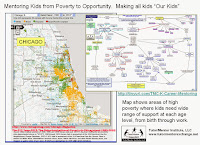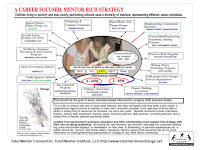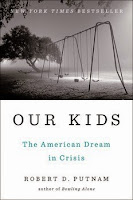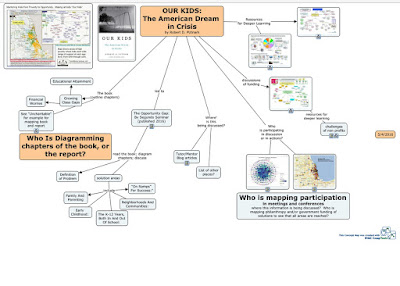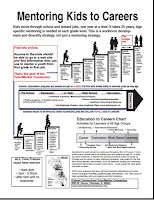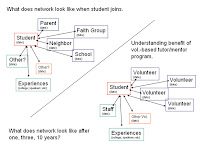In the article he referred to Dr. Robert Putnam's "Our Kids: The American Dream in Crisis" book, which I've written about in several past articles.
I've supported organized, on-going, volunteer-based #tutor and #mentor programs for nearly 40 years because of their potential to build connections between people who don't live in poverty and young people and families who do.
As I said, I've written a series of articles that refer to Dr. Putnam's book. I'd like to highlight a few here.
March 24, 2015 - Closing Opportunity Gap in America. Making All Kids "Our Kids. I included this graphic in the article, which I created in the mid 1990s to show a vision of a tutor/mentor program with volunteers from many different business/professional backgrounds. This depicts the expansion of mentors and learning experiences in the lives of kids who participate in these programs. It also shows the multi-dimensional support of programs by volunteers and donors from many different industries. It focuses on muti-year support, from first grade into jobs. It also includes a map, showing that such programs need to reach kids in every high poverty neighborhood.
Putnam and Reeves both posted several suggestions. One was "invest in well organized mentoring" programs. I'd like to see more of a road map that shows how we do this. How do we get to where we are today to a future when this opportunity gap has been significantly diminished.
May 5, 2016 - Follow up to Putnam Talk in Chicago. I included this map story, which was first created in 1996, to illustrate a need to use maps to show the gaps between rich and poor, to show all of the high poverty areas of the Chicago region, and to force (and guide) a distribution of needed resources and mentor-rich programs to more of those neighborhoods. I also demonstrate using map-stories as part of an on-going effort to draw more attention and to increase the flow of volunteer and donors to individual tutor/mentor programs. I still don't see any leaders in Chicago using maps this way .
 |
| See at this link |
As I've found articles like "Trickle Down Norms", I started putting them in a library I was building, which was originally intended to support myself and the leaders and volunteers in the single Chicago tutor/mentor program I started leading in 1975. When we formally formed the Tutor/Mentor Connection in 1993 we created an intentional process for finding this information and sharing it with leaders and supporters of tutor/mentor programs throughout Chicago. When we built our first web site in 1998 we began sharing this library with the world, while also finding ideas from other cities that could be applied to building new solutions in Chicago.
 |
| See at this link |
In this article I wrote about the difference between the terms "bridging" and "bonding" social capital. This page on the Saguaro Seminar at Harvard University site provides those definitions
In my work, I focus on "bridging" social capital, or social ties that link people together with others across a cleavage that typically divides society (like race, or class, or religion).
There are several more articles that refer to Putnam's book on this blog and many others that focus on learning, network building, media, leadership, etc. You can't read all of these in one day, or a week. Why not form a learning circle in your business, faith group, college or family, and read and discuss one article a week? Why not connect with myself and each other on Twitter, the way the #clmooc group has been doing since 2013?
 |
| Chicago Tribune 1994 |
I've shared ideas like these, since forming the Tutor/Mentor Connection in 1993, with most of the candidates running for Governor of Illinois, and with the current and former Mayor of Chicago. Yet, if you visit their web sites you don't see any concept maps similar to those I've shared, nor a mobilization and learning strategy similar to the four-part strategy that I've shared. You don't see their support on anything I've done. I'm not part of any of their planning committees, nor funded as a consultant to their own efforts.
I wonder if they have read Putnam, or Reeves, or any of my articles.
Nothing will change until more people read, reflect, share and then apply these ideas, and the many resources I've aggregated in the Tutor/Mentor Connection web library, using their own personal, and professional, time, talent, dollars and votes.
Search "Putnam" on this blog to find all articles where I've referred to the "Our Kids" book and talked about bridging and bonding social capital.
Note: Since 2011 I've kept the Tutor/Mentor Connection operating under the structure of Tutor/Mentor Institute, LLC. If you'd like to support me, click here for information.
7-20-2023 update - Read new report showing importance of relationships and intentional building of social capital via organized programs, and funding challenges of creating and sustaining such programs. click here
Note: Since 2011 I've kept the Tutor/Mentor Connection operating under the structure of Tutor/Mentor Institute, LLC. If you'd like to support me, click here for information.
7-20-2023 update - Read new report showing importance of relationships and intentional building of social capital via organized programs, and funding challenges of creating and sustaining such programs. click here
